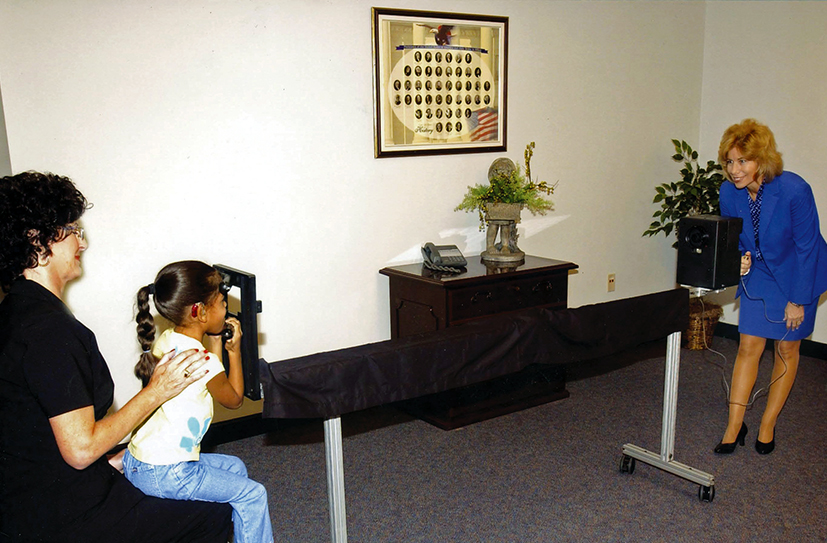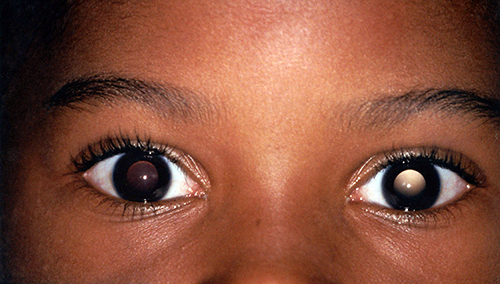
Photorefraction Screens Millions for Vision Disorders
Originating Technology/NASA Contribution
Who would have thought that stargazing in the 1980s would lead to hundreds of thousands of schoolchildren seeing more clearly today? Collaborating with research ophthalmologists and optometrists, Marshall Space Flight Center scientists Joe Kerr and the late John Richardson adapted optics technology for eye screening methods using a process called photorefraction. Photorefraction consists of delivering a light beam into the eyes where it bends in the ocular media, hits the retina, and then reflects as an image back to a camera. A series of refinements and formal clinical studies followed their highly successful initial tests in the 1980s.
Evaluating over 5,000 subjects in field tests, Kerr and Richardson used a camera system prototype with a specifically angled telephoto lens and flash to photograph a subject’s eye. They then analyzed the image, the cornea and pupil in particular, for irregular reflective patterns. Early tests of the system with 1,657 Alabama children revealed that, while only 111 failed the traditional chart test, Kerr and Richardson’s screening system found 507 abnormalities.
Partnership
In 1991, NASA transferred the exclusive license for the system to the Vision Research Corporation (VRC), of Birmingham, Alabama, after Kerr sold his company to VRC. Jim Kennemer, VRC’s president, says the basic technology is still the same in 2008. “What makes this work is the optics, the distance, the angles, and the flash. We retained the basic optical principles.”
Also in 1991, VRC began a two-pronged marketing effort for the VisiScreen Ocular Screening System-Clinical (OSS-C): sales to pediatricians and family practitioners, and the widespread distribution of screening services to school systems and other organizations with large numbers of children. That year, the Russell Corporation (based in Alexander City, Alabama, and now also in Atlanta) joined forces with VRC to conduct a large-scale eye-screening program in Russell’s employee daycare centers. In approximately 10 percent of the children, the program identified previously unsuspected vision problems significant enough to warrant follow-up examination by an eye care professional. Because several eye conditions can worsen and even cause blindness if not caught early, there were clear benefits in continuing the screenings.
The success of this program led Russell Corporation to collaborate with Alabama Power and the Alabama State Department of Education to sponsor a program for all kindergarten students in the state. “That was the first statewide eye screening program using advanced technology in the country,” Kennemer says. VRC also contributed to the growth of the nonprofit organization, Sight Savers of Alabama, to provide vision care and assistance to needy children.
VRC has since used VisiScreen to check over 3 million children in schools and daycare centers. “The NASA technology that has made our screening programs possible has truly changed the lives of hundreds of thousands of children,” Kennemer says. This impact is one of the reasons the Space Foundation inducted VisiScreen into the Space Technology Hall of Fame in 2003.
Product Outcome
Using photorefraction, VRC’s VisiScreen photographs a patient’s eyes at a specific distance and angle; light enters the eye, reflects off the retina, and returns an image to the screening system. Specialists at VRC later analyze the images and issue a report to the family or physician, indicating areas of possible concern.
Although not intended to replace examination by an eye care professional, VisiScreen can highlight possible problems that a child’s parents and teachers may not have noticed. The system can detect common childhood vision problems, including myopia (nearsightedness), hyperopia (farsightedness), astigmatism (corneal irregularities), strabismus (alignment errors), and cataracts, which occur in roughly 1 in every 1,000 infants.
VisiScreen tests the eye for refractive error and obstruction in the cornea or lens. The photorefractor analyzes the retinal reflexes generated by the subject’s response to the flash. If the eye is properly focusing the light, as happens in a child with normal vision, a smooth, clear “red eye” image of the retina reflects evenly from the pupils. For a child who is hyperopic, a bright half-moon reflects from the top of the pupil. In the case of myopia, a crescent in the bottom half of the eye reflects more brightly than the top. Similarly, other potential problem areas reflect differently than a properly focused eye would.
The system provides several major advantages over traditional vision screening with letter or picture charts: children do not need to respond during the test, so anyone, including an infant, can be screened regardless of age or verbal ability; the process is also as quick as taking a photograph, so screeners can process large numbers of patients rapidly.
Pediatricians and family doctors in over 20 states use VisiScreen to identify possible vision problems in children, who are then referred to ophthalmologists and optometrists for diagnosis and treatment. VRC screened approximately 150,000 Alabama elementary school students during the 2007-2008 school year, and continues to offer its services across the Southeast. According to Kennemer, “Over 3,000 had indications of a difference in the power of the eyes called anisometropia, which can indicate or lead to amblyopia.”
Commonly known as “lazy eye,” amblyopia can cause permanent vision loss in the weaker eye if not detected and corrected early enough; “it is the leading cause of preventable blindness in children,” Kennemer explains. Since its inception, VisiScreen has found amblyopic factors in over 70,000 children, or approximately 1 child in 40. “These screenings are vitally important,” Kennemer says, “because if children are not treated before age 6 or 7, they may suffer permanent vision loss; in addition, amblyopia leads to 17 percent of all adult total blindness. Although blindness is not a concern for most children in the screenings, limited vision can affect both social and educational development. A child who cannot see well is at an obvious disadvantage in the classroom, and those who fall behind early in their education are more likely to have additional problems later.”
Through the efforts of VRC and VisiScreen, NASA has improved the lives of hundreds of thousands of children whose eye problems may have remained undiagnosed or otherwise untreated.VRC is planning more improvements and enhancements to VisiScreen, and soon will begin field testing a new generation of the screening system.
VisiScreen® is a registered trademark of Vision Research Corporation.

Shown here, anisometropia is a condition in which a patient’s eyes have unequal refractive power. If not caught early enough, anisometropia can cause amblyopia, or lazy eye. Vision Research Corporation’s screening program has found over 3,000 children with indications of anisometropia.

A specialist from the Vision Research Corporation (right) uses the VisiScreen to photograph a patient’s eyes at a specific distance and angle. Specialists at VRC later analyze the images and issue a report to the family or physician, indicating areas of possible concern.













